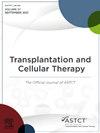Simple, Rapid, Reproducible and Biomarker-Validated Clinical Grading System for Murine Models of Xenogeneic Graft-Versus-Host Disease
IF 3.6
3区 医学
Q2 HEMATOLOGY
引用次数: 0
Abstract
Experiment models of xenogeneic graft-versus-host disease (xeno-GVHD), in which human immune cells are injected into immunodeficient mice, are increasingly used to study human immune cell behavior in vivo and to test therapeutic approaches. Today, the main, and more commonly accepted clinical parameters used to characterize xeno-GVHD are weight loss and mortality. These criteria do not provide an accurate and subtle assessment of the disease intensity, nor do they reflect the great variability of xeno-GVHD, which depends on the donor. Relying on previous work in which we described an original clinical grading system for assessing GVHD in mice, we propose an adaptation of this system for xeno-GVHD models. This simple, solid, and reproducible scoring system of xeno-GVHD is constituted of the binary (yes or no) evaluation of 4 easy-to-evaluate parameters that reflect the complexity of the disease without the need to sacrifice the mice. This scoring system is consistent with the gold standard histological grading of human GVHD and with numerous biomarkers characteristic of the disease. We propose this new clinical grading system to evaluate and compare the results obtained with a common tool, regardless of the experimenters and laboratories where the experiments would have been carried out and whatever the therapeutic strategy evaluated.
用于异种移植物抗宿主病小鼠模型的简单、快速、可重复性和生物标志物验证的临床分级系统。
异种移植物抗宿主病(xeno-GVHD)的实验模型是将人类免疫细胞注射到免疫缺陷小鼠体内,越来越多地用于研究人类免疫细胞在体内的行为和测试治疗方法。今天,用于表征异种gvhd的主要和更普遍接受的临床参数是体重减轻和死亡率。这些标准不能提供对疾病强度的准确和微妙的评估,也不能反映异种gvhd的巨大变异性,这取决于供体。根据之前的工作,我们描述了一种用于评估小鼠GVHD的原始临床分级系统,我们提出了一种适用于异种GVHD模型的系统。这个简单、可靠、可重复的xeno-GVHD评分系统由四个易于评估的参数的二元(是或否)评估组成,这些参数反映了疾病的复杂性,而无需牺牲小鼠。该评分系统与人类GVHD的金标准组织学分级一致,并具有该疾病的许多生物标志物特征。我们提出这个新的临床分级系统来评估和比较用一个通用工具获得的结果,而不管实验人员和实验室在哪里进行实验,也不管评估的治疗策略是什么。背景:将人类免疫细胞注射到免疫缺陷小鼠体内的异种移植物抗宿主病(xeno-GVHD)实验模型越来越多地用于研究人类免疫细胞在体内的行为和测试治疗方法。今天,用于表征异种gvhd的主要和更普遍接受的临床参数是体重减轻和死亡率。这些标准不能提供对疾病强度的准确和微妙的评估,也不能反映异种gvhd的巨大变异性,这取决于供体。目的:根据我们先前描述的用于评估小鼠GVHD的原始临床分级系统,我们提出了一种适用于异种GVHD模型的系统。研究设计:这个简单、可靠、可重复的xeno-GVHD评分系统由四个易于评估的参数(是或否)组成,这些参数反映了疾病的复杂性,而无需牺牲小鼠。结果:该评分系统与人类GVHD的金标准组织学分级一致,并具有该疾病的许多生物标志物特征。结论:我们提出了这个新的临床分级系统来评估和比较用一个通用工具获得的结果,而不管实验人员和实验室在哪里进行实验,也不管评估的治疗策略是什么。
本文章由计算机程序翻译,如有差异,请以英文原文为准。
求助全文
约1分钟内获得全文
求助全文
来源期刊

Transplantation and Cellular Therapy
Medicine-Hematology
CiteScore
7.00
自引率
15.60%
发文量
1061
审稿时长
51 days
 求助内容:
求助内容: 应助结果提醒方式:
应助结果提醒方式:


